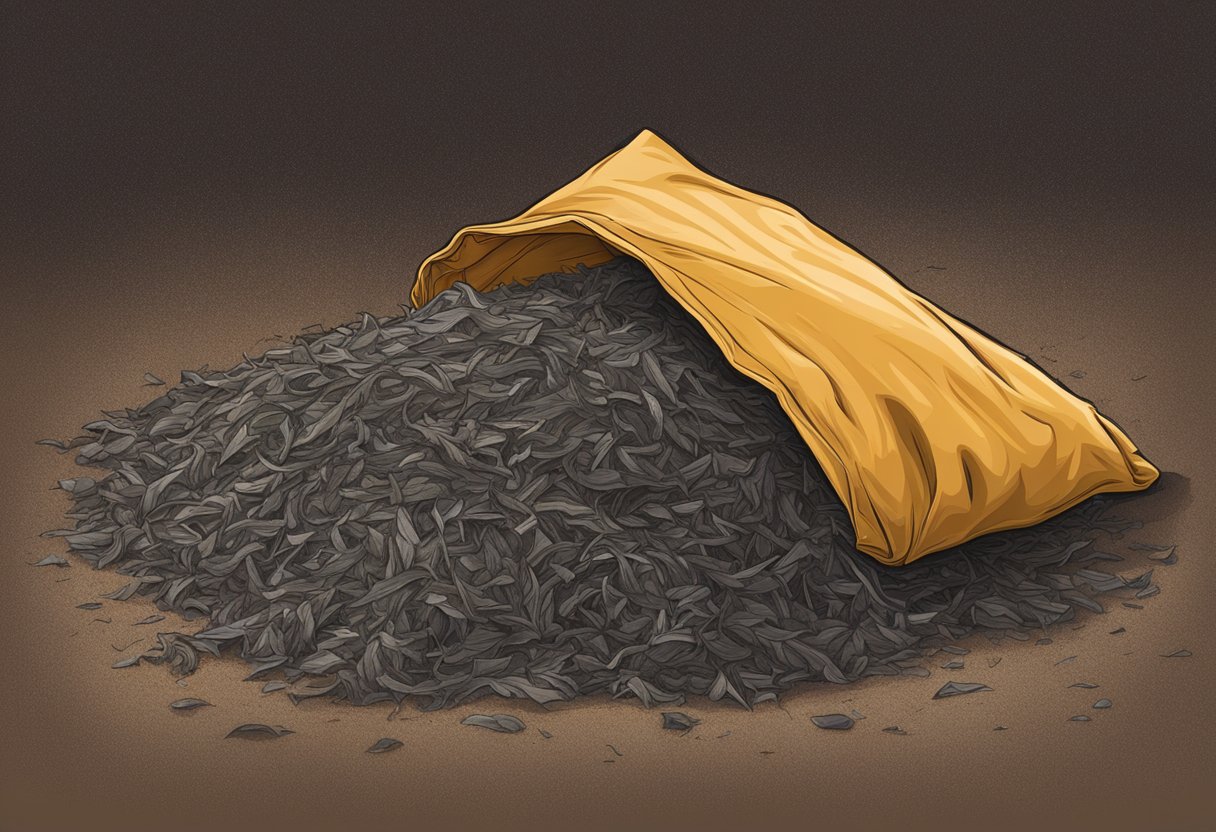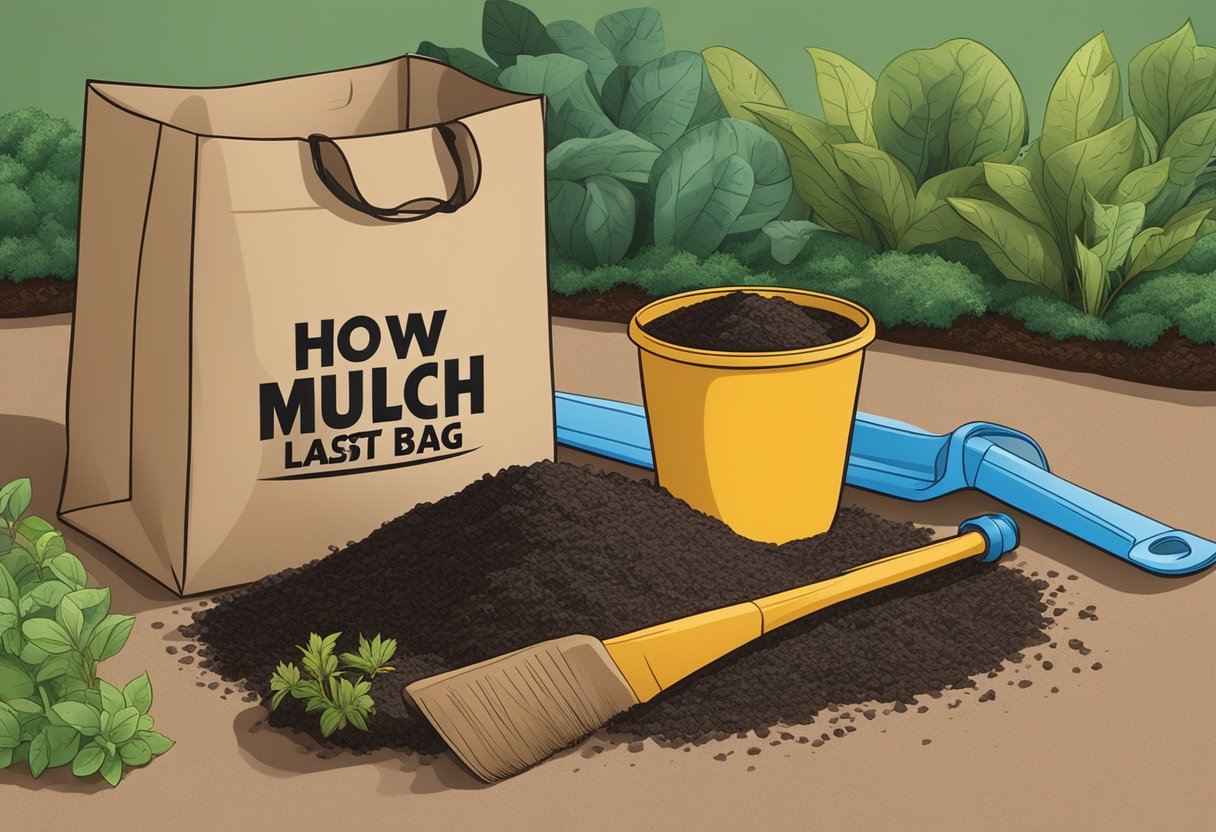Mulch is integral to our gardens, protecting soil from erosion, helping retain moisture, and suppressing weeds. We often buy it in bags, which allows for easy transport and storage. The lifespan of mulch in an unopened bag is influenced by factors like the type of mulch, the materials used, and the storage conditions.

Organic mulches such as wood chips or straw naturally decompose over time. In a sealed bag, this process is significantly slower due to reduced exposure to air and moisture, which are catalysts for decomposition. Under ideal storage conditions – dry, cool, and out of direct sunlight – bagged mulch can last for several years before it begins to break down.
However, our experience shows that even under the best circumstances, the quality of mulch can start to degrade after about one year. The material may not be as vibrant or effective when finally spread in our gardens. To ensure optimal performance, we prefer to use mulch within the first year of purchase, monitoring the bags for any signs of moisture or pests that could hasten decomposition.
Factors Influencing Mulch Longevity
When discussing how long mulch lasts in a bag, we consider several factors, including the rate of decomposition, the presence of moisture, and the local climate conditions.
Decomposition and Decay
Mulch is organic and will gradually decompose over time; this process is natural and inevitable. The speed at which mulch decays depends on the material composition. For instance, harder woods decompose slower than softer ones. Decomposition is accelerated by microorganisms like fungi and bacteria which thrive on organic materials. We ensure the mulch stays dry and well-aerated to slow decay.
- Hardwood Mulch: Typically 3-4 years
- Softwood Mulch: Approximately 2-3 years
Moisture and Mold Growth
Moisture plays a pivotal role in mulch longevity. While some water is necessary for mulch to function effectively, excessive moisture can lead to mold growth. This not only reduces the aesthetic value but also hastens decomposition.
- Keep bags dry: Store them under cover to minimize exposure to water.
- Check regularly: We look out for signs of mold or fungi, indicative of too much moisture.
Temperature and Climate Effects
Lastly, climate conditions significantly affect how long mulch lasts in a bag. We notice that mulch stored in cool, dry areas tends to last longer compared to those kept in hot, humid climates where heat can increase microbial activity that breaks down organic matter. Seasonal variations will also either impede or expedite the natural breakdown process.
- In hot & humid climates: Decomposition is faster.
- In cool & dry regions: Mulch longevity increases.
Proper Storage of Bagged Mulch
When storing bagged mulch, it’s crucial to choose the right location, ensure the area is well-ventilated and dry, and safeguard the bags from pests and fungus to maintain its quality.
Choosing the Right Storage Location
We must consider both convenience and environmental factors when selecting a storage spot for our bagged mulch. It should be a place that’s easily accessible for us but also doesn’t expose the mulch to direct sunlight, as this can degrade the quality over time. Typically, a shaded area that remains consistently cool is ideal. The ground should be level to prevent the bags from tearing and moisture from seeping in. Concrete slabs or pallets are great for keeping the bags off the ground and away from direct contact with soil.
Maintaining Ventilation and Dryness
To prolong the lifespan of our bagged mulch, we have to ensure good ventilation and dry conditions. If the mulch gets damp, it can lead to decay and mold growth within the bag. We always make sure the storage area has enough airflow to prevent the accumulation of moisture. In high humidity environments, it’s beneficial to use a tarp over the stacked bags, keeping them covered yet not fully sealed off from the air. The tarp should not touch the bags directly to allow for sufficient air circulation.
Protecting Mulch from Pests and Fungus
A key part of proper storage is keeping pests and fungus at bay. We avoid placing bagged mulch directly on the earth where insects and fungus spores are more prevalent. Elevating the bags on shelves or pallets can significantly reduce the risk of infestation. Additionally, we inspect our bags for any rips or openings and seal them because even a small tear can invite pests. For added protection, we can sprinkle natural repellents like cedar oil around the storage area to deter any would-be intruders without harming the quality of the mulch.
Extending the Shelf Life of Mulch
In maintaining the longevity of bagged mulch, we must address factors such as weed suppression, moisture regulation, and fungal growth prevention. These measures are critical to ensure that the mulch retains its quality over time.
Utilizing Weed Barrier Fabrics
Weed barrier fabrics act as a defence mechanism against weed infiltration which can expedite the degradation of mulch. By layering the mulch on top of these fabrics, we create a physical barricade that not only restrains weed growth but also stabilizes moisture levels. This practice serves to preserve the integrity and appearance of the mulch for longer periods.
Monitoring and Controlling Moisture
Controlling the moisture content of mulch is imperative:
- To avoid excessive dryness, we ensure mulch bags are stored in a cool, shaded area away from direct sunlight.
- For preventing moisture accumulation, which can lead to mold, we punctuate storage areas to facilitate air flow.
- We recommend periodic checks of the mulch’s moisture levels and make adjustments by aerating the bags, if necessary, fostering a balanced environment.
Preventative Measures Against Fungal Growth
To thwart fungal growth, we take proactive steps:
- Store mulch off the ground on pallets to reduce the risk of fungus transfer from the soil.
- Use mulch bags with water-repellent properties to minimize water retention and avert mold.
- In cases where the climate is humid, consider adding natural fungicides to the mulch that deter the establishment of mold and fungi without harming the mulch’s efficacy.
Identifying and Dealing with Bad Mulch
In managing our gardens, we must know how to recognize and address issues with bad mulch to maintain plant health.
Signs of Mold and Fungus in Mulch
Mold and fungus can appear in mulch, indicating decomposition and lessened efficacy. Notable signs include:
- White, yellow, or green patches: These are typically mold or mildew.
- Musty smell: A strong scent reminiscent of mold or dampness.
- Slime or stickiness: This suggests the presence of yeast or fungus.
- Discoloration: Often a precursor to mold.
Leveraging our experience, we handle these signs immediately to prevent the spread to plants.
Handling Rotten or Decomposed Mulch
When mulch begins to decompose, it should be dealt with promptly:
- Identify: Rotten mulch often emits a sulfuric odor, akin to rotten eggs.
- Remove: Use gloves and tools to remove the affected mulch.
- Compost: If partially decomposed without harmful fungus, composting is an option.
- Replace: Add fresh, high-quality mulch to keep the area healthy.
A homemade vinegar solution may be used to treat the affected area before adding new mulch, ensuring an inhospitable environment for unwanted mold and fungus. By staying vigilant and acting quickly, we protect our gardens from the negative impacts of decomposing mulch.
Using Old Mulch in Gardening
When we encounter bags of aged mulch, we can still employ them beneficially in our gardens. Integrating this old mulch into our soil management practices often leads to improved soil health and, subsequently, healthier plants.
Incorporating Aged Mulch into Compost
Materials:
– Aged mulch
– Existing compost pile or bin
- Assess the condition of the old mulch to determine its suitability for composting.
- Mix the aged mulch with green waste (e.g., kitchen scraps, grass clippings) in a 1:2 ratio to balance carbon and nitrogen.
- Turn the compost pile regularly to aerate and facilitate decomposition.
- Monitor the pile’s moisture levels, ensuring it remains as wet as a wrung-out sponge.
Incorporating aged mulch into our compost pile is an effective way to recycle the material. It adds carbon-rich content that, in turn, improves the overall nutrient profile of the compost.
Reviving Mulch for Plant Health
Steps:
- Examine the texture and moisture content of the old mulch. If it’s dry, refresh it with water.
- Spread the mulch around plants, maintaining a gap around plant stems to prevent rot.
- Consider adding a nitrogen supplement if the mulch is particularly carbon-heavy to avoid nitrogen depletion in the soil.
By reviving and distributing old mulch in our gardens, we not only conserve resources but also contribute to the well-being of our plants. The mulch helps maintain soil moisture, suppresses weeds, and eventually breaks down to enrich the soil structure.
Seasonal Considerations for Mulch Storage
As the seasons change, so do the strategies for storing mulch effectively. Preserving its quality requires understanding the specific challenges each season brings.
Preparing Mulch for Spring Planting
When spring approaches, we prioritize making mulch accessible for planting. It’s essential to store bags in a dry area to prevent moisture accumulation, which can lead to mold. Ideally, we keep the bags off the ground on pallets to enhance drainage and air circulation. To protect against unexpected rain, we might cover the stacks with a tarp, ensuring it’s secured but allows air flow to prevent condensation.
Storing Mulch Through Fall and Winter
During fall and into winter, our focus shifts to protecting mulch from the wet conditions typical of these seasons. Any excess moisture can compromise the mulch’s integrity, making it less effective when eventually used. To circumvent this, we store mulch bags in a covered, dry area, shielded from direct contact with rain and snow. We take extra measures to ensure the storage spot has adequate drainage to deal with any water that might accumulate.
Practical Tips for Handling Mulch
When working with bagged mulch, we need to consider the logistics of transporting, calculating the correct quantity, and the techniques for spreading it efficiently and effectively.
Transporting Bagged Mulch
To transport bagged mulch successfully, first ensure that your vehicle can bear the weight and that the bags are secure. A wheelbarrow serves as the best means for moving mulch from the vehicle to the garden site. Keep the wheelbarrow in a well-balanced position to prevent strain on your back and to reduce the risk of the bags falling off during transit.
Determining the Proper Amount of Mulch
Calculating the right amount of mulch involves understanding the area’s depth and thickness requirements. For most mulching projects, aiming for a layer about 2 to 4 inches deep is ideal. Calculate the area’s square footage and then use the following table to estimate the number of 2-cubic-foot bags needed:
| Area in Square Feet | Depth (2 inches) | Depth (4 inches) |
|---|---|---|
| 100 | 8 bags | 16 bags |
| 200 | 16 bags | 32 bags |
| 300 | 24 bags | 48 bags |
Remember, it’s always better to have a little extra than to run short.
Methods for Spreading Mulch
When it comes to spreading mulch, using a rake is the most efficient tool for achieving an even layer. Start by placing the bags strategically around the area, cutting them open and spreading them out. Then, rake the mulch to the desired thickness. This ensures even coverage without over-mulching, which can suffocate plants. Always opt for high-quality mulch as it lasts longer and is often more eco-friendly, improving our garden’s health without causing harm to the environment.